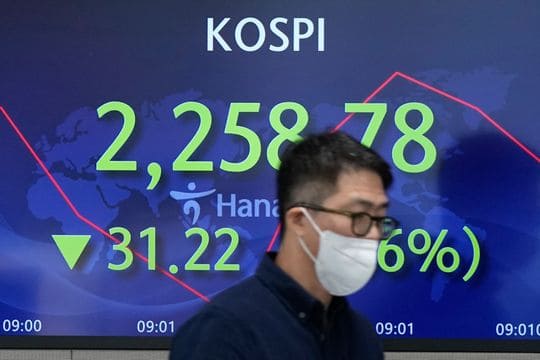Stocks sink sharply in Tokyo, Sydney, Seoul
TOKYO — Asian shares were mostly lower Monday, reflecting pessimism over weakness on Wall Street as the squeeze by central banks around the world to curb inflation weighs on investor sentiment.
Japan’s benchmark Nikkei 225 JP:NIK dropped 2% in morning trading. Australia’s S&P/ASX 200 AU:XJO dipped 1.6% and South Korea’s Kospi KR:180721 dropped 2.4%. Hong Kong’s Hang Seng HK:HSI was about flat, as was the Shanghai Composite CN:SHCOMP. Benchmark indexes in Singapore SG:STI, Taiwan TW:Y9999 and Indonesia ID:JAKIDX declined.
“Momentum may follow from the further sell-off on Wall Street to end last week, with strength in the U.S. dollar weighing on Asian indices,” Yeap Jun Rong, a market strategist at IG in Singapore, said in a report.
The recent moves by the U.S. Federal Reserve and other central banks around the world to raise interest rates are designed to curb high inflation, but they also threaten a recession, if the rates rise too much or too quickly.
Wall Street ended last week with widespread selling, leaving major indexes with their fifth loss in six weeks. Data on European business activity was discouraging, and a separate report suggested U.S. activity is also still shrinking, though not quite as badly as in earlier months.
The S&P 500 SPX sank 1.7% on Friday, to 3,693.23, its fourth straight drop. The Dow DJIA, which at one point was down more than 800 points, lost 486.27 points, or 1.6%, to close at 29,590.41. The Nasdaq COMP fell 1.8% to 10,867.93.
More than 85% of stocks in the S&P 500 closed in the red, with technology companies, retailers and banks among the biggest weights on the benchmark index.
Last week, the Fed lifted its benchmark rate, which affects many consumer and business loans, to a range of 3% to 3.25%. It was near zero at the start of the year. The Fed also released a forecast suggesting its benchmark rate could be 4.4% by the year’s end, a full point higher than envisioned in June.
In energy trading on Monday, benchmark U.S. crude CLX22 rose 12 cents to $78.86 a barrel in electronic trading on the New York Mercantile Exchange. U.S. crude oil prices slid 5.7% Friday to their lowest levels since early this year on worries that a weaker global economy will burn less fuel.
Brent crude BRNX22, the international standard, edged up 6 cents to $86.21 a barrel.
In currency trading, the recent rise in the U.S. dollar USDJPY has been a concern, stoking worries about dented profits for U.S. companies with overseas business, and putting a financial squeeze on much of the developing world.
When the dollar approached 146 yen last week, the Bank of Japan intervened. The dollar has been trading at about 143 yen since then.
It edged up Monday to 143.75 Japanese yen from 143.32 yen.

